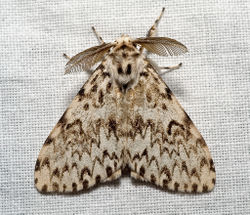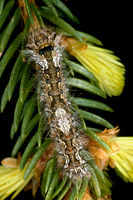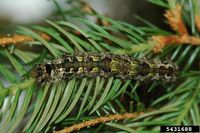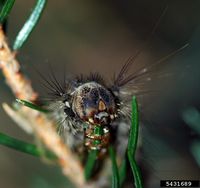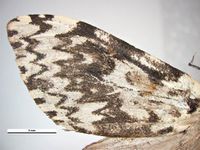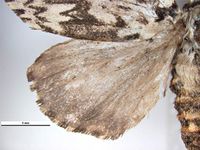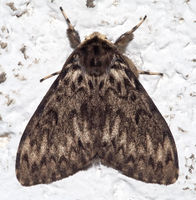Difference between revisions of "Lymantria monacha"
| (One intermediate revision by the same user not shown) | |||
| Line 1: | Line 1: | ||
| − | {{ | + | {{TaxLinks|LnkLymantria}} |
{{LiteratureDB|{{PAGENAME}}|browse,crops,benefialsN}} | {{LiteratureDB|{{PAGENAME}}|browse,crops,benefialsN}} | ||
[[File:Lymantria monacha02.jpg|250px|thumb|''Lymantria monacha'' male (click on image to enlarge it)<br/>Source: [http://commons.wikimedia.org/wiki/File:Lymantria_monacha02.jpg Wikimedia Commons]]] | [[File:Lymantria monacha02.jpg|250px|thumb|''Lymantria monacha'' male (click on image to enlarge it)<br/>Source: [http://commons.wikimedia.org/wiki/File:Lymantria_monacha02.jpg Wikimedia Commons]]] | ||
| − | <font color="#800000">'''''Lymantria monacha'''''</font> Linnaeus - tussock moth | + | <font color="#800000">'''''Lymantria monacha'''''</font> Linnaeus - (tussock moth) |
| − | + | ||
| − | For | + | The moth is a serious polyphagous forest pest in Europe and northern Asia which causes periodic serious outbreaks. Such outbreaks have been recorded during the last 500 years in Europe. For example, in Poland 6 outbreaks have been recorded during the period 1946-1995. The last outbreak in Europe was in 2003 in Germany and Poland. |
| + | Typically, the defoliation level exceeds 80% in the centre of an outbreak. In particular spruce, and to a lesser extent larch and pine trees are attacked. However, other trees may also be damaged during outbreaks, although outbreaks have been rarely recorded from pure deciduous forests. | ||
{{VN | {{VN | ||
| − | |||
|de=Nonne | |de=Nonne | ||
| + | |en=tussock moth<br/>nun moth | ||
| + | |es=la monja | ||
| + | |fr=la Nonne | ||
}} | }} | ||
| + | Females lay up to 300 eggs in clusters of 20-100 on tree trunks. After hatching, the larvae stay together for a day or two, before dispersing by climbing up into the foliage or hang on silk threads and are carried to other trees by the wind. The adult moths have a wingspan of 4-5 cm. Females are larger than males and have more elongated wings. Most adults have white forewings with black connected wavy arches. Dark forms, sometimes completely black are also sometimes observed and during one outbreak around 50% of the moths were dark. | ||
| + | |||
| − | <gallery widths=200px caption="Other images of Lymantria monacha (IPM Images | + | <gallery widths=200px caption="Other images of Lymantria monacha (IPM Images, PaDIL and Wikimedia Commons - click to enlarge)"> |
File:Lymantria_monacha_IPM2515023.jpg|larva | File:Lymantria_monacha_IPM2515023.jpg|larva | ||
File:Lymantria_monacha_IPM5431688.jpg|larva on spruce | File:Lymantria_monacha_IPM5431688.jpg|larva on spruce | ||
| Line 18: | Line 22: | ||
File:Lymantria_monacha_PaDIL136274a.jpg|forewing | File:Lymantria_monacha_PaDIL136274a.jpg|forewing | ||
File:Lymantria_monacha_PaDIL136274b.jpg|female, hindwing | File:Lymantria_monacha_PaDIL136274b.jpg|female, hindwing | ||
| + | File:Lymantria monacha01.jpg|dark form (female) | ||
</gallery> | </gallery> | ||
[[Category:Lymantria (genus)]] | [[Category:Lymantria (genus)]] | ||
Latest revision as of 17:38, 2 July 2015
| Literature database |
|---|
| 41 articles sorted by: |
| • year (recent ones first) |
| • research topics |
| • countries/regions |
| • host plants |
| • list of natural enemies |
Lymantria monacha Linnaeus - (tussock moth)
The moth is a serious polyphagous forest pest in Europe and northern Asia which causes periodic serious outbreaks. Such outbreaks have been recorded during the last 500 years in Europe. For example, in Poland 6 outbreaks have been recorded during the period 1946-1995. The last outbreak in Europe was in 2003 in Germany and Poland.
Typically, the defoliation level exceeds 80% in the centre of an outbreak. In particular spruce, and to a lesser extent larch and pine trees are attacked. However, other trees may also be damaged during outbreaks, although outbreaks have been rarely recorded from pure deciduous forests.
| Vernacular names | |
|---|---|
| • Deutsch: | Nonne |
| • English: | tussock moth nun moth |
| • Español: | la monja |
| • Français: | la Nonne |
Females lay up to 300 eggs in clusters of 20-100 on tree trunks. After hatching, the larvae stay together for a day or two, before dispersing by climbing up into the foliage or hang on silk threads and are carried to other trees by the wind. The adult moths have a wingspan of 4-5 cm. Females are larger than males and have more elongated wings. Most adults have white forewings with black connected wavy arches. Dark forms, sometimes completely black are also sometimes observed and during one outbreak around 50% of the moths were dark.
- Other images of Lymantria monacha (IPM Images, PaDIL and Wikimedia Commons - click to enlarge)
